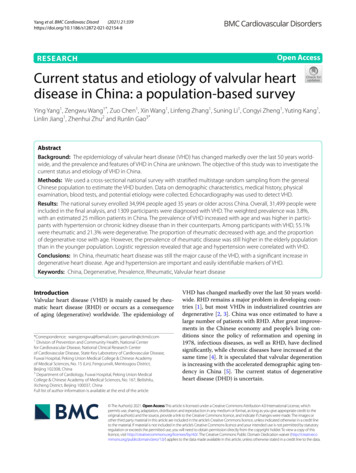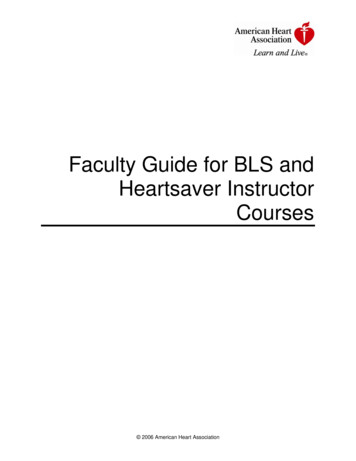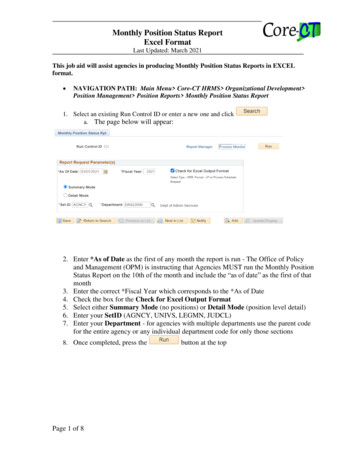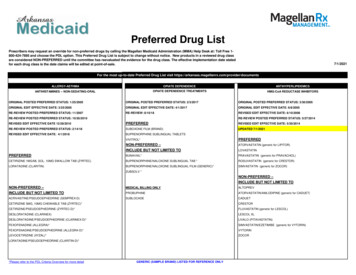
Transcription
(2021) 21:339Yang et al. BMC Cardiovasc en AccessRESEARCHCurrent status and etiology of valvular heartdisease in China: a population‑based surveyYing Yang1, Zengwu Wang1*, Zuo Chen1, Xin Wang1, Linfeng Zhang1, Suning Li1, Congyi Zheng1, Yuting Kang1,Linlin Jiang1, Zhenhui Zhu2 and Runlin Gao3*AbstractBackground: The epidemiology of valvular heart disease (VHD) has changed markedly over the last 50 years worldwide, and the prevalence and features of VHD in China are unknown. The objective of this study was to investigate thecurrent status and etiology of VHD in China.Methods: We used a cross-sectional national survey with stratified multistage random sampling from the generalChinese population to estimate the VHD burden. Data on demographic characteristics, medical history, physicalexamination, blood tests, and potential etiology were collected. Echocardiography was used to detect VHD.Results: The national survey enrolled 34,994 people aged 35 years or older across China. Overall, 31,499 people wereincluded in the final analysis, and 1309 participants were diagnosed with VHD. The weighted prevalence was 3.8%,with an estimated 25 million patients in China. The prevalence of VHD increased with age and was higher in participants with hypertension or chronic kidney disease than in their counterparts. Among participants with VHD, 55.1%were rheumatic and 21.3% were degenerative. The proportion of rheumatic decreased with age, and the proportionof degenerative rose with age. However, the prevalence of rheumatic disease was still higher in the elderly populationthan in the younger population. Logistic regression revealed that age and hypertension were correlated with VHD.Conclusions: In China, rheumatic heart disease was still the major cause of the VHD, with a significant increase indegenerative heart disease. Age and hypertension are important and easily identifiable markers of VHD.Keywords: China, Degenerative, Prevalence, Rheumatic, Valvular heart diseaseIntroductionValvular heart disease (VHD) is mainly caused by rheumatic heart disease (RHD) or occurs as a consequenceof aging (degenerative) worldwide. The epidemiology of*Correspondence: wangzengwu@foxmail.com; gaorunlin@citmd.com1Division of Prevention and Community Health, National Centerfor Cardiovascular Disease, National Clinical Research Centerof Cardiovascular Disease, State Key Laboratory of Cardiovascular Disease,Fuwai Hospital, Peking Union Medical College & Chinese Academyof Medical Sciences, No. 15 (Lin), Fengcunxili, Mentougou District,Beijing 102308, China3Department of Cardiology, Fuwai Hospital, Peking Union MedicalCollege & Chinese Academy of Medical Sciences, No. 167, Beilishilu,Xicheng District, Beijing 100037, ChinaFull list of author information is available at the end of the articleVHD has changed markedly over the last 50 years worldwide. RHD remains a major problem in developing countries [1], but most VHDs in industrialized countries aredegenerative [2, 3]. China was once estimated to have alarge number of patients with RHD. After great improvements in the Chinese economy and people’s living conditions since the policy of reformation and opening in1978, infectious diseases, as well as RHD, have declinedsignificantly, while chronic diseases have increased at thesame time [4]. It is speculated that valvular degenerationis increasing with the accelerated demographic aging tendency in China [5]. The current status of degenerativeheart disease (DHD) is uncertain. The Author(s) 2021. Open Access This article is licensed under a Creative Commons Attribution 4.0 International License, whichpermits use, sharing, adaptation, distribution and reproduction in any medium or format, as long as you give appropriate credit to theoriginal author(s) and the source, provide a link to the Creative Commons licence, and indicate if changes were made. The images orother third party material in this article are included in the article’s Creative Commons licence, unless indicated otherwise in a credit lineto the material. If material is not included in the article’s Creative Commons licence and your intended use is not permitted by statutoryregulation or exceeds the permitted use, you will need to obtain permission directly from the copyright holder. To view a copy of thislicence, visit http:// creat iveco mmons. org/ licen ses/ by/4. 0/. The Creative Commons Public Domain Dedication waiver (http:// creat iveco mmons. org/ publi cdoma in/ zero/1. 0/) applies to the data made available in this article, unless otherwise stated in a credit line to the data.
Yang et al. BMC Cardiovasc Disord(2021) 21:339There are few data on the prevalence of VHD, especially in developing countries, in contrast to the manystudies on percutaneous interventional techniques inthis field. The main difficulty in obtaining such data is therequirement of high-quality echocardiographic examinations in a large, representative sample. In a pooled population-based study in 2006, Nkomo et al. reported thatthe prevalence of VHD was 2.5% in American adults [6].In the UK, a recent population-based study reported a51% VHD prevalence in the older population [7]. Previous studies conducted in hospitals or a single province inChina reported limited information on the etiology andseverity of VHD [8–10]. The aim of this study, therefore,is to assess the current status and etiology of VHD fromthe echocardiography data of a large nationwide population sample.MethodsStudy populationThis was a prospective cross-sectional study conductedbetween October 2012 and December 2015. A multistage random sampling method was used to obtain anationwide sample representing the general populationover 15 years old across all 31 provinces in the Chinahypertension survey [11, 12]. Permanent residents randomly chosen from 262 urban cities and rural countieswere enrolled. To further study VHD prevalence, all 262selected urban and rural areas were stratified into eastern, middle, and western regions to represent both geographical location and economic level. Using the simplerandom sampling method, 16 cities and 17 counties wereselected, including 7 cities and 7 counties in the eastern region, 6 cities and 6 counties in the middle region,and 3 cities and 4 counties in the western region. Then,at least three communities or villages were randomlyselected from each city or county. To meet the designedsample size of 35,000 participants aged 35 years andtaking nonresponses into account, 56,000 subjectswere randomly selected from the eligible sites. Finally,34,994 participants completed the survey, for an overallresponse rate was 62.5%. After excluding subjects without demographic information (n 627), laboratory tests(n 1 257), and inadequate echocardiographic images(n 1611), 31,499 subjects were included in the finalanalysis.Data collectionA standardized questionnaire was specifically developedfor this study to collect demographic characteristics,lifestyle and history of disease by experienced medicalstaff. The history of cardiac diseases, such as myocardialinfarction, coronary artery bypass grafting surgery, percutaneous coronary intervention, congestive heart failurePage 2 of 9and so on, was documented in detail. For the purpose ofidentifying comorbidities, all instances of hypertension,stroke, hyperlipidemia, diabetes mellitus, and chronickidney disease (CKD) were also recorded in the questionnaire. Subsequently, physical examination, electrocardiogram, and echocardiography were performed on eachparticipant at the local medical centers (town/countyhospitals). Blood samples were collected to test for bloodlipids, glucose, and creatinine in a designated lab.Hypertension was defined as systolic blood pressure(BP) 140 mmHg and/or diastolic BP 90 mmHg and/or the use of antihypertensive medication within thelast two weeks. Diabetes was defined as fasting plasmaglucose level 7.0 mmol/L and/or taking hypoglycemic agents or insulin. Dyslipidemia was defined as totalcholesterol 6.22 mmol/L, low-density lipoproteincholesterol (LDL-C) 4.14 mmol/L, high-density lipoprotein cholesterol (HDL-C) 1.04 mmol/L, triglycerides 2.26 mmol/L, a combination thereof, or takinglipid-lowering drugs. CKD was defined as decreasedkidney function, expressed as an estimated glomerular filtration rate 60 ml/min/1.73 m2 by the MDRDequation or a ratio of albumin and creatinine in a urinesample 30 mg/mmol [13, 14]. AF was verified by thecurrent ECG report or verified AF history. Participantswere diagnosed with systolic heart failure(HF) based onsymptoms and a transthoracic echocardiogram showingleft ventricular ejection fraction (LVEF) 50% or medicalrecords issued by a local county or higher-level hospital.Echocardiography proceduresTransthoracic echocardiography was performed in theparticipant’s local medical center by experienced sonographers who were trained uniformly to quantify cardiacchambers according to the requirements of this study.Two experts from Fuwai Hospital supervised the fieldinvestigation in each local medical center. 2D imageswere acquired and measured in the parasternal (standard long- and short-axis images) and apical views (2-,4-chamber, and apical long-axis images). The assessmentof valvular stenosis and regurgitation by Doppler wascarried out as recommended by the American Societyof Echocardiography [15, 16]. Aortic stenosis was classified as none, mild, moderate and severe according tothe highest aortic jet velocities: 2.6 m/s, 2.6–2.9 m/s,3.0–4.0 m/s and 4.0 m/s, respectively. A subject withaortic maximal jet velocity 2.6 m/s was diagnosedwith aortic stenosis (AS) and was enrolled in the currentstudy. Subjects with a mitral valve area 2.0 cm2 weredefined as having mitral stenosis (MS). Comprehensivemeasurements, including quantitative and semiquantitative methods, are commonly used for evaluating valvular regurgitation. All images and data were stored in
Yang et al. BMC Cardiovasc Disord(2021) 21:339a database and transferred via the internet to the coordinating centers to be evaluated by experts on the imagequality and measurement accuracy. Discrepancies wereresolved to achieve a mutual consensus at the same time.VHD was confined to findings of mild or more severestenosis and moderate or more severe regurgitation, consistent with the pioneer study in Europe [17]. A valveinvolved with stenosis and/or regurgitation was considered valvular dysfunction. Any participant with multiple valvular dysfunctions was counted only once in theVHD definition. RHD was diagnosed definitely by the2012 World Heart Federation criteria, according to thepathological valvular dysfunctions in the left heart andspecific morphological features (for example, mitralvalve leaflet thickening) [18]. DHD required the presence of mitral and/or aortic leaflet sclerosis and calcification in the absence of rheumatic features (such ascommissural fusion) and valvular congenital abnormalities among those above 60 years old, regardless of thefunctional status. The DHD also covered mitral valveprolapse. Valve replacement was confirmed by medicalhistory and detection of the prosthetic valve by echocardiography. Congenital heart diseases (CHDs) includedatrial septal defects, ventricular septal defects, pulmonary stenosis, bicuspid and quadricuspid aortic valves,double-orifice mitral valves, and persistent left superiorvena cava. Ischemia was verified by medical history withtypical electrocardiographic changes (Q wave) or echocardiographic detection of myocardial ischemia, which isbased on visualizing a regional decrease in systolic endocardial motion and myocardial thickening. The causesof secondary VHD included ischemia, nonvalvular atrialfibrillation (AF), HF, dilated cardiomyopathy, hypertrophic cardiomyopathy, and CHDs except for congenitalvalvular anomalies. Some VHDs had unclear etiologiesbased on available information and were classified as“other”.StatisticsAll data in the analysis were weighted based on the 2010China population census data [19]. The demographicand clinical characteristics were collected from participants with and without VHD. Descriptive statistics forthe study are presented as means with 95% confidenceintervals (CIs) for continuous variables and percentageswith 95% CIs for categorical variables. Student’s t-testand the chi-squared test or Fisher’s exact test were usedto compare groups with and without VHD. The prevalence of major valvular dysfunctions was stratifiedby age, sex and comorbidities. A bar graph was usedto show the distribution of etiologies in different agestrata. A logistic regression model was used to assessPage 3 of 9associations between VHD and demographic characteristics. The variables adjusted and results expressedas odds ratios (ORs) with 95% CIs are listed in the forest plot. A two-tailed P value 0.05 was considered significant. Statistical analyses were conducted with SASversion 9.4 (SAS Institute INC, Cary, NC, USA).ResultsOf all 31,499 participants, the mean age was 51.8 years,and 49.3% were female (Table 1). The participants withVHD were older than those without VHD, and 48.2%were male. All diseases and comorbidities were different (P 0.001) between the VHD and non-VHD groupsexcept for diabetes.The weighted prevalence of VHD was 3.8% (95%CI 2.6–5.6, Table 2) out of an estimated 25,621,503patients in China according to the 2010 census data.The prevalence of VHD, which increased with age(P 0.001), was not different between males andfemales (P 0.308) and was higher in participants withhypertension (5.6% vs 2.8%, P 0.001) and CKD (9.2%vs 3.5%, P 0.001) than in their counterparts. Overall,the most common VHD was aortic regurgitation (AR,1.2%), followed by mitral regurgitation (MR, 1.1%), tricuspid regurgitation (TR, 0.8%), and MS (0.8%).The etiologies of VHD stratified by age are shown inFig. 1 (data listed in Additional file 1: Table S2). Theproportion of RHD was 55.1%. It dropped from 77.8%in those aged 35–44 to 38.0% in those aged 75 years.The proportion of DHD was 21.3%, rising from 18.2%in the 55–64 age group to 42.5% in those aged 75 yearsabove. Secondary VHD accounted for 12.1%, while thevalve replacement etiology made up 0.9%. The crudeprevalence of VHD due to the two common etiologies in different sexes and ages is shown in Fig. 2. Theinverted pyramid showed that the prevalence of RHDin the elderly (2.64% in men and 3.71% in women) wasapparently higher than that in those aged 35–54 (0.79%in men and 1.33% in women). Multiple logistic regression was employed to explore the associations betweendemographic characteristics and VHD (Fig. 3). VHDwas positively associated with age and hypertensionand negatively correlated with BMI.Single aortic dysfunction (n 496), including stenosis and/or regurgitation, was the most frequent typeof valvular dysfunction (Additional file 1: Fig. S1), followed by single mitral dysfunction (n 367). The mostcommon double dysfunction was aortic valve diseasecombined with mitral valve (n 132), and the mostcommon triple dysfunction involved the aortic, mitral,and tricuspid valves (n 35).
Yang et al. BMC Cardiovasc Disord(2021) 21:339Page 4 of 9Table 1 Characters of the study population with and without valvular heart diseaseTotal (n 31,499)VHD (n 1309)No VHD (n 30,190)Male (%)50.7 (49.0–52.5)48.2 (42.9–53.5)50.8 (49.0–52.7)Female (%)49.2 (47.3–51.0)GenderP value0.30849.3 (47.5–51.0)51.8 (46.5–57.1)Age (mean, years)51.8 (51.0–52.5)61.6 (59.9–63.2)51.4 (50.7–52.1) 0.001BMI (mean, Kg/m2)24.7 (24.3–25.0)24.2 (23.5–24.9)24.7 (24.3–25.1)0.058East (%)44.1 (20.1–68.2)49.2 (15.4–82.9)43.9 (20.1–67.8)Central (%)34.5 (11.0–58.0)21.7 (7.8–47.8)35.0 (11.3–58.7)West (%)21.4 (8.0–45.9)29.1 (0.0–61.7)21.0 (7.9–45.2)Rural (%)37.5 (22.3–52.7)44.3 (15.1–73.7)37.2 (22.4–52.0)Urban (%)62.5 (47.3–77.7)55.7 (26.4–84.9)62.8 (48.0–77.6)Region0.134Residence0.407Heart diseases historyIschemia (%)0.5 (0.2–1.0)1.9 (0.8–4.8)0.4 (0.2–0.9) 0.001AF (%)0.7 (0.5–1.1)4.5 (2.9–6.9)0.6 (0.4–0.9) 0.001Systolic HF (%)0.8 (0.6–1.1)3.9 (2.6–5.9)0.7 (0.5–1.0) 0.001DCM (%)0.3 (0.2–0.5)3.5 (1.8–6.7)0.2 (0.1–0.3) 0.001HCM (%)0.2 (0.1–0.4)0.8 (0.3–2.0)0.2 (0.1–0.3) 0.001CHD (%)0.2 (0.1–0.4)1.4 (0.6–3.3)0.1 (0.0–0.3) 0.00135.1 (32.8–37.4)51.9 (48.4–55.4)34.4 (32.2–36.7) 0.0011.6 (1.0–2.4)3.3 (1.8–6.1)1.5 (1.0–2.3)0.00432.4 (28.4–36.4)28.9 (23.6–34.1)32.5 (28.5–36.5)0.015Diabetes (%)8.5 (7.5–9.7)9.0 (7.5–10.8)8.5 (7.4–9.8)0.581CKD (%)4.6 (3.7–5.7)11.0 (8.4–14.2)4.3 (3.5–5.3) 0.001LAap (mm)31.2 (30.4–32.1)34.3 (32.9–35.7)31.1 (30.3–32.0) 0.001LVEDD (mm)46.2 (45.5–47.0)48.2 (47.2–49.2)46.2 (45.4–46.9) 0.0019.6 (9.3–9.8)10.0 (9.4–10.6)9.5 (9.2–9.8)LVESD (mm)30.0 (29.3–30.8)32.2 (31.1–33.3)30.0 (29.2–30.7) 0.001LVEF (%)64.4 (62.8–65.9)62.7 (60.7–64.7)64.4 (62.9–66.0) 0.001ComorbiditiesHypertension (%)Stroke (%)Dyslipidemia (%)Echocardiography measurementsIVSd (mm)0.077Data were represented as means or percentage (95% CI)All values were weighted to represent the total population of Chinese aged 35 years or older based on the Chinese census 2010VHD, valvular heart disease; BMI, body mass index; AF, atrial fibrillation; HF, heart failure; DCM, Dilated Cardiomyopathy; HCM, Hypertrophic Cardiomyopathy; CHD,congenital heart disease; CKD, chronic kidney disease. LAap, the anteroposterior diameter of the left atrium; LVEDD, the diameter of the left ventricle at end-diastole;IVSd, the thickness of the interventricular septum; LVESD, the left ventricle end-systolic diameter; LVEF, the left ventricle ejection fractionP value for t-test (continuous) and x2 or Fisher’s exact test (categorical) to assess the difference between population with VHD and those without itDiscussionThe current study aimed to describe the prevalence ofVHD in a large sample from the general population ofChina. The results revealed that VHD is common andincreases with age. Furthermore, RHD remains the leading cause of valvular dysfunction, and DHD is becomingan increasing problem in China. These findings suggesta tremendous burden of VHD due to a large populationthat is rapidly aging, and they call for echocardiographicscreening.The VHD prevalence of 2.5% in the US was lower thanthat in the current study [6]. The discrepancy could beattributed to different definitions (including only moderate or severe valvular stenosis and not mild stenosis) andthe inclusion of more young participants. Another studywas conducted among 2500 individuals aged 65 years,in which the prevalence (51%) was rather high [7]. Beforethe current study, the prevalence of VHD in China hasnot yet been determined based on available information from hospitals [8, 20]. Our results revealed that the
Yang et al. BMC Cardiovasc Disord(2021) 21:339Page 5 of 9Table 2 Prevalence of valvular heart diseases (VHD) in the left heart according to 4993.8 (2.6–5.6)0.8 (0.5–1.3)1.1 (0.7–1.7)0.7 (0.4–1.1)1.2 (0.7–2.1)GenderMale14,4703.6 (2.5–5.2)0.8 (0.4–1.6)1.0 (0.7–1.4)0.8 (0.4–1.4)1.3 (0.8–2.2)Female17,0294.0 (2.6–6.1)0.8 (0.5–1.3)1.2 (0.7–2.1)0.6 (0.3–1.0)1.2 (0.7–2.0)0.3080.9670.0960.1940.459PAge (years)35–4468491.9 (1.1–3.2)0.7 (0.3–1.5)0.4 (0.2–0.7)0.4 (0.2–0.7)0.3 (0.1–0.8)45–5474062.1 (1.4–3.0)0.5 (0.3–1.0)0.7 (0.5–1.0)0.3 (0.1–0.8)0.4 (0.3–0.8)55–6467654.5 (3.0–6.8)0.7 (0.4–1.2)1.5 (0.9–2.4)0.5 (0.3–1.0)1.4 (0.8–2.6)65–7464067.6 (5.1–11.2)1.4 (0.7–2.5)2.1 (1.3–3.3)1.5 (0.8–2.8)3.1 (1.7–5.7)75-407315.9 (10.3–23.7)2.1 (1.1–3.8)5.2 (3.2–8.3)3.4 (1.7–6.7)7.1 (4.0–12.3) 0.0010.002 0.001 0.001 0.001PBMI (Kg/m2) 18.513196.2 (3.7–10.4)1.6 (0.6–4.7)1.7 (0.6–4.4)0.7 (0.2–1.8)3.1 (1.6–6.1)18.5–23.913,0364.0 (2.6–6.0)0.7 (0.4–1.4)1.2 (0.8–1.8)0.7 (0.3–1.3)1.2 (0.6–2.1)24–27.912,0423.7 (2.4–5.5)0.8 (0.5–1.3)1.1 (0.6–1.9)0.7 (0.4–1.1)1.2 (0.7–1.9)28-51023.1 (1.9–5.0)0.9 (0.5–1.5)0.9 (0.5–1.5)0.6 (0.3–1.4)1.1 0094.2 (2.5–7.1)0.9 (0.5–1.8)1.0 (0.6–1.5)0.8 (0.4–1.6)1.8 (1.0–3.3)Central11,8952.4 (1.0–5.9)0.4 (0.1–0.9)1.1 (0.4–2.9)0.2 (0.1–0.6)0.6 (0.2–2.1)West55955.2 (2.8–9.5)1.2 (0.4–4.3)1.4 (0.5–3.9)1.1 (0.3–3.5)1.1 l15,0094.5 (2.5–7.9)0.9 (0.4–1.9)1.3 (0.7–2.4)0.8 (0.4–1.6)1.4 (0.7–2.9)Urban16,4903.4 (2.0–5.6)0.7 (0.4–1.5)1.0 (0.6–1.7)0.6 (0.3–1.3)1.1 o18,1632.8 (1.9–4.2)0.6 (0.4–1.1)0.8 (0.5–1.3)0.4 (0.2–0.6)0.7 (0.4–1.2)Yes13,3365.6 (3.8–8.3)1.1 (0.7–1.8)1.6 (1.0–2.4)1.2 (0.6–2.3)2.2 (1.3–3.6) 0.001 0.001 0.001 0.001 0.001PDyslipidemiaNo21,8304.0 (2.7–5.9)0.8 (0.5–1.4)1.1 (0.8–1.7)0.7 (0.4–1.1)1.3 (0.8–2.2)Yes96693.4 (2.2–5.1)0.7 (0.4–1.3)1.0 (0.6–1.8)0.6 (0.3–1.2)1.0 2143.8 (2.6–5.6)0.8 (0.5–1.3)1.1 (0.7–1.6)0.6 (0.4–1.0)1.2 (0.7–2.1)Yes32854.0 (2.5–6.3)1.0 (0.6–1.9)1.5 (0.8–2.9)1.2 (0.5–2.6)1.3 63.7 (2.5–5.5)0.8 (0.5–1.3)1.1 (0.7–1.7)0.6 (0.4–1.1)1.2 (0.7–2.0)Yes8437.9 (4.0–15.1)1.3 (0.4–3.8)1.9 (0.8–4.7)1.8 (0.7–4.6)4.1 (2.2–7.8)0.0040.2950.1850.003 0.001PCKDPNo29,4533.5 (2.4–5.2)0.7 (0.4–1.2)1.0 (0.7–1.5)0.6 (0.4–1.0)1.1 (0.7–1.9)Yes20469.2 (6.0–13.9)2.3 (1.3–4.0)3.0 (1.7–5.1)1.6 (0.7–3.5)3.2 (1.5–6.5) 0.001 0.001 0.0010.001 0.001Data were represented as a percentage (95% CI)All values were weighted to represent the total population of Chinese aged 35 years or older based on the Chinese census 2010VHD, valvular heart disease; MS, mitral stenosis; MR, mitral regurgitation; AS, aortic stenosis; AR, aortic regurgitation; BMI, body mass index; CKD, chronic kidneydiseaseP value for x2 or Fisher’s exact test to assess the difference of prevalence among subgroups according to the characteristics
Yang et al. BMC Cardiovasc Disord(2021) 21:339Page 6 of 9Fig. 1 The proportions of etiologies of valvular heart disease according to age (The related dataset were seen in Additional file 1: Table S2).CA congenital anomaly; VR valve replacementFig. 2 The prevalences of VHD due to the two common etiologies in different gender and age. The prevalence were reported as number 10–3without weightprevalence was sensitive to age, the same as in the Western world.The marked decrease in the prevalence of rheumaticdisease in Western countries has been largely counterbalanced by the increased prevalence of DHD with theaging of the population [21]. China’s situation is slightlydifferent. A study from a single cardiovascular centerin southern China showed that the prevalence of RHDdecreased significantly, but the prevalence of congenital VHD, ischemic VHD, and DHD increased markedly;however, RHD remained the leading etiology in southern China [8]. In 2019, a report showed that rheumaticorigin was still the predominant etiology of left-sidedvalve disease in Chinese patients hospitalized for VHD[22]. The current results are in line with previous studies.Unlike in the West, rheumatic origin is the most frequentetiology, followed by degenerative causes, in China,Uganda and Tunisia [23, 24]. In our study, the burdenof RHD was mainly derived from the older population,especially those aged 75 years and older. With the rapid
Yang et al. BMC Cardiovasc Disord(2021) 21:339Page 7 of 9Fig. 3 Factors related to valvular heart disease calculated by logistic regression (BMI body mass index)development of the economy and improvement of residents’ living conditions in the past 40 years, the incidenceof RHD has been significantly reduced in China [4, 25,26]. Young people are unlikely to be affected, and patientswith RHD are aging. In brief, RHD and DHD are bothmajor health threats to Chinese old people and deservemore attention.In 2007, the Euro Heart Survey, which included 5001patients from 92 medical centers in 25 European countries, reported that AS and MR accounted for 43.1% and33.6%, respectively, of single-valve diseases and weremostly caused by degenerative diseases [27]. The subsequent survey in 2017 further highlighted the findings ofthe previous results on VHD [21]. The same increasingtrend for AS and MR was also demonstrated in Sweden,the UK and the US [6, 7, 28]. However, most studies inChina, including ours, have shown that regurgitation isthe main burden rather than aortic stenosis [20, 22, 29].Compared with stenosis, the symptom of chronic regurgitation is likely to be unspecific, while compared toMR, the symptom of AR tends to be hidden because ofthe strong ability of the left ventricle to compensate forthe overload of end-diastolic volume. Therefore, patientswith underlying single AR might not check with theirdoctors in a timely manner. This might explain the relatively low rate of AR in symptomatic patients admittedto the hospital. The results of the current study suggestthat the prevalence of AR among hospitalized patientsmight be underestimated. The multiple involvement ofdegenerative changes (aging, hypertension and atherosclerosis) and RHD might be another reason for the highprevalence of AR. Hypertension accelerates degenerativechanges in the aortic valve and annulus and might be theresult of AR [30]. In addition to AR, age and hypertensionare also observed to exert an influence on the prevalenceof MR. The mechanism is longstanding mechanical stressand increased afterload, respectively, as documented bythe Framingham study [31]. Regurgitation accounts forthe majority of VHD cases, corresponding to the agingof the population and the high incidence of hypertensionin China. The study above [31] reported that the prevalence of MR and TR decreased as an increasing BMI.The authors speculated poor ultrasonic penetration andinadequate detection of Doppler signals. The inverserelation between BMI and VHD was shown in the current results. The similar effects called obesity paradoxhad been shown in many chronic diseases [32]. Besidesthe technical factors, there were several potential mechanisms through which the paradox could arise [33]. However, there were also evidence that intentional weight lossremains protective in the patients with higher BMI.The prevalence of any valve disease increases with age [34].In 2010, there were 258 million people aged 55 years old andabove in China, and the population aging is progressivelyincreasing. In the future, there will be a much larger elderlypopulation presenting with VHD. VHD is frequently diagnosed in old patients with clinical complications, such as HF,and common comorbidities, such as diabetes and coronaryartery disease, which also increase the risks of treatment.VHD is a progressive disease that may be silent fordecades. It has been reported that early identificationand treatment could avoid and delay heart failure from
Yang et al. BMC Cardiovasc Disord(2021) 21:339long-term overvolume and overpressure. Auscultation isa widely available method to detect VHD in large populations, but its sensitivity is limited [35]. Therefore, echoscreening for early identification and prevention, as recommended by the WHO [36] in the 1980s, might also behelpful given the aging tendency.The study has several limitations. First, this is a crosssectional study, which means that some patients withacute or severe VHD, such as infective endocarditis, chordae rupture, and latrogenic injuries, were notincluded. Second, although the investigators have donetheir best to confirm the causes of VHD, it is hard toattribute all VHDs to clear etiologies. Third, the prevalence of VHD is associated with economic development.The income of the participants is hard to obtain in mostepidemiological studies. Instead, the different regionsare used to represent the economic levels in China. Normally, the economic level is lowest in the Western region,middle in the Central region, and highest in the Eastregion. However, the current results did not reveal thedifference in the prevalence of VHD among regions.ConclusionTo the best of our knowledge, this is the first populationbased study aimed at estimating the prevalence of VHDby echocardiography in China. AR followed by MR is themost frequent valvular dysfunction in China. Despite asignificant decrease of rheumatic fever in the past years,it has shown that RHD remains the leading etiology inChina, but there has been a significant increase in DHD.Age and hypertension are important and easily identifiable markers for screening and preventing VHD.AbbreviationsAF: Atrial fibrillation; AR: Aortic regurgitation; AS: Aortic stenosis; BP: Bloodpressure; CHD: Congenital heart diseases; CI: Confidence intervals; CKD:Chronic kidney disease; DHD: Degenerative heart disease; HDL-C: High-densitylipoprotein cholesterol; HF: Heart failure; LDL-C: Low-density lipoproteincholesterol; LVEF: Left ventricular ejection fraction; MR: Mitral regurgitation;MS: Mitral stenosis; RHD: Rheumatic heart disease; TR: Tricuspid regurgitation;VHD: Valvular heart disease.Supplementary InformationThe online version contains supplementary material available at https:// doi. org/ 10. 1186/ s12872- 021- 02154-8.Additional file 1 More results of the analysis.Additional file 2 The full list of work staff for the survey.AcknowledgementsThe survey was accomplished through the fine work of the staff at thenational level, and we thank all the colleagues involved in the survey (seeAdditional file 2). We are grateful to OMRON Corporation, Kyoto, Japan, forsupporting Blood Pressure Monitor (HBP-1300) and body fat and weightPage 8 of 9measurement device (V-body HBF-371); Henan Huanan Medical Science &Technology Co., Ltd, China for Digital ECG device (GY-5000); Microlife, Taipei,China for Automated ABI device (WatchBP Office device). We are also gratefulto BUCHANG PHARMA, Xian, China, Pfizer China, and Essen Technology (Beijing) Company Limited for providing funding for the project.Authors’ contributionsZW is the guarantor and attests that all listed authors meet authorship criteriaand that no others meeting the cr
Valvular heart disease (VHD) is mainly caused by rheu - matic heart disease (RHD) or occurs as a consequence of aging (degenerative) worldwide. e epidemiology of VHD has changed markedly over the last 50 years world-wide. RHD remains a major problem in developing coun tries [1], but most VHDs in industrialized countries are degenerative [3].










